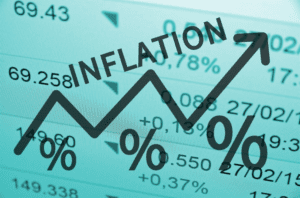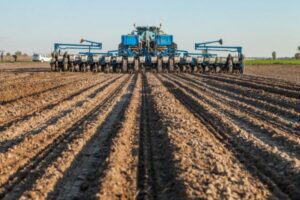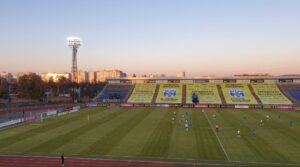
Global demand for steel in 2022 will increase by only 0.4% and amount to 1.84 billion tons (1.834 billion tons in 2021), the World Steel Association predicts.
In 2023, according to WSA expectations, steel demand will increase by 2.2%, to 1.881 billion tons.
The total demand for steel in the Russian Federation, CIS countries and Ukraine this year, according to WSA forecasts, will fall by 23.6% to 44.6 million tons (58.5 million tons in 2021). In 2023, an increase of 1.1% is expected, to 45.1 million tons. At the same time, steel consumption in Russia will fall by 20%, to 35.1 million tons against 43.9 million tons in 2021.
CIS COUNTRIES, DEMAND, RUSSIA, STEEL, WORLD STEEL ASSOCIATION

Inflation in Ukraine by the end of 2022 may exceed 20% due to the consequences of a full-scale war, but it will be controlled, the National Bank of Ukraine said on Thursday.
According to the report, the increase in the price of goods and services will be due, in particular, to disruption of production processes, logistical problems due to the temporary occupation of part of the territories, the destruction of transport infrastructure and, as a result, an unevenly distributed supply across individual regions.
In addition, the inflation growth will be affected by the pass-through effects of the devaluation of the hryvnia exchange rate that occurred on the eve of the war and the high cost of energy in the world, which will put pressure on the cost of fuel, goods and services with a significant share of energy in the cost.
At the same time, price growth will be restrained by measures taken by the National Bank and the government of Ukraine, including temporary fixing of the hryvnia exchange rate, which curbs the likely worsening of expectations and an increase in the price of imported goods, tax cuts, including indirect taxation of imports, price fixing for housing and communal services, and administrative regulation of prices for a number of foodstuffs and fuels.
An additional constraint will have an oversupply of certain agricultural crops due to limited export opportunities.
It is indicated that after the resumption of the functioning of monetary transmission channels, the National Bank will again apply the discount rate and other monetary instruments to keep inflation expectations under control and gradually reduce inflation.

Uber, after receiving an approval from the city authorities, resumes work in Kyiv, the company’s press service said on Thursday.
At the same time, the company notes that it will not charge a commission for the service, so the full cost of trips will go to drivers.
“From today, Uber has resumed operations in Kyiv. To support the city’s immediate recovery, Uber will not charge any ride fees, meaning the full fare paid by passengers will go directly to local drivers. Uber will also donate 10,000 free rides to government employees and other critical infrastructure workers who provide the necessary assistance and services to the people of Kiev,” Anabel Diaz, regional manager of Uber in Europe, the Middle East and Africa, was quoted as saying.
Uber also continues to operate in other Ukrainian cities: Lviv, Ternopil, Ivano-Frankivsk, Vinnitsa, Chernivtsi, Khmelnitsky, Lutsk and Rivne.
In addition, the company added that in addition to resuming core operations, Uber continues to initiate social projects in cooperation with non-governmental organizations, volunteer centers and businesses to support Ukrainians.
Uber, in particular, offers promotional codes for free trips to blood donation centers for donors from DonorUA – they are available in all cities where the platform operates (in Kyiv, Lviv, Chernivtsi, Vinnitsa, Ivano-Frankivsk, Ternopil, Khmelnitsky, Rivne and Lutsk). In addition, Uber recently launched the Uber Connect&Van service in Lviv with a special promotional code for donating goods for internally displaced persons. The initiative is implemented in cooperation with the NGO “Volunteer Hundred Lions”.
In Ukraine and Poland, Uber has launched a special Uber Aid service that allows Ukrainians to travel to the borders for free.
The Uber Donate button in the app has already raised $3.5 million worldwide, according to the company.

For the period from mid-March to April 13, Ukrainian banking institutions provided loans to farmers under the state program to support the sowing campaign-2022 for a total of UAH 5.43 billion, including loans and portfolio guarantees for the week of March 6-13. UAH 3.64 billion
The relevant data on the financing of the sowing campaign in the context of the Russian military invasion of Ukraine was published on the website of the Ministry of Agrarian Policy and Food of Ukraine on Thursday.
“In fact, over a week, loans were issued for more than UAH 3.6 billion for more than a thousand farmers. Banks took a rather fast pace to cover the needs of our agricultural producers, who are now undergoing a sowing campaign. Today, agricultural loans can be issued by 22 Bank, and the goal of the state is to increase lending to the agricultural sector up to UAH 40 billion, that is, almost eight times more,” the department quotes its head, Mykola Solsky.
It is specified that 80% (UAH 4.41 billion) of the provided borrowed funds were portfolio guarantees, while 2.08 thousand agricultural producers received access to financing in total (1.18 thousand in the last week).
Most of the loans for the sowing campaign were attracted by the agrarians of Kirovohrad region – UAH 1.81 billion (+UAH 1.4 billion for the week), Vinnitsa region – UAH 944 million (+UAH 579 million), Dnepropetrovsk region – UAH 738 million (+UAH 471 million), Odesa – UAH 549 million (+UAH 388 million) and Lviv – UAH 348 million (+UAH 189 million) regions.
According to the Ministry of Agrarian Policy, loans up to UAH 60 million under this program are issued at 0% per annum (under the state financial support program “Affordable loans 5-7-9%”). The term of such lending is up to six months, and after its completion, the interest rate for borrowers will be 5% per annum. Agrarians falling under the definition of an agricultural producer can use the loan.
“Ukraine understands its defining role as a guarantor of the food security of the world, so we must harvest to feed ourselves, and also prevent food shortages and hunger in the world,” Solsky summed up in the message of the Ministry of Agrarian Policy.
The agency recalled that the government program to support the sowing campaign is being implemented by the Cabinet of Ministers, the Ministry of Agrarian Policy, the Ministry of Finance, the Ministry of Economy, the National Bank and the banking sector.
As reported, at the end of March, the Cabinet of Ministers of Ukraine expanded the procedure for issuing guarantees for agricultural producers on loans on a portfolio basis for the purchase of the resources they need for the sowing campaign in 2022, since due to the Russian military invasion of Ukraine, part of the farmers lost working capital for carrying out spring work.
Thus, within the framework of portfolio lending to agricultural producers, they will be able to obtain loans for the purchase of fertilizers, plant protection products, pesticides and agrochemicals, fuel, spare parts for agricultural equipment, as well as for replenishment of fixed assets and intangible assets, wages, rent of real estate and movable property, works and services for its operations.
The total budget of this program to support the 2022 sowing season is UAH 50 billion.

Minister of Culture and Information Policy Oleksandr Tkachenko says that Germany and the Dortmund club will help restore the football stadium in Chernihiv destroyed by Russian troops.
“Germany and the Dortmund club are ready to help restore the stadium in Chernihiv destroyed by the Russian occupation forces. The club remembers its player and the cool Ukrainian footballer Andriy Yarmolenko. For our part, we join Mayor Vladislav Atroshenko in the dialogue and hope that this wonderful news will be able to support Chernihiv residents,” Tkachenko wrote in the telegram channel following negotiations with Claudia Roth, Minister of State for Culture and Media of the Federal Chancellor’s Office.
According to the minister, Germany stressed its unchanging position on the importance of rescheduling the 45th session of the UNESCO World Heritage Committee from Russian Kazan.
In addition, the parties discussed the initiative to include the historical area of Odessa in UNESCO.

The Lychakivsky District Court of Lviv, on the proposal of the State Bureau of Investigation (SBI) and the Office of the Prosecutor General, arrested 154 objects of movable and immovable property of People’s Deputy of Ukraine Viktor Medvedchuk and his wife Oksana Marchenko.
“Among those arrested: 26 cars, 30 land plots, 23 houses, 32 apartments, 17 parking spaces and a motor yacht. Shares in authorized capital in 25 companies, the beneficial owner of which is Viktor Medvedchuk or his wife, were also arrested,” the press release said. RBI service on Facebook.
Earlier, the court had already arrested the yacht and part of Medvedchuk’s real estate.
As reported, on Tuesday evening, a photograph of Medvedchuk in military uniform and handcuffs appeared on the Telegram channel of Ukrainian President Volodymyr Zelensky. It was accompanied by the text “A special operation was carried out thanks to the SBU. Well done!”
Zelensky offered Russia to exchange Medvedchuk for Ukrainian citizens who are held captive by the Russian military.
The head of the SBU, Ivan Bakanov, said that the FSB planned to take Medveduk through Transnistria to Moscow. According to him, under the guise of a serviceman of the Armed Forces of Ukraine, he was supposed to be taken to the border and transported by boat to the other side, where the FSB special forces evacuation group was already waiting for him, which, according to the plan, was supposed to deliver him to Moscow.
“This allowed operatives, SBU investigators to detain Medvedchuk on the road … near the border of the Kiev region or at the exit from the Kiev region. All this time, Medvedchuk was accompanied by Ukrainian law enforcement officers, who, in my opinion, will also be responsible for their actions,” Bakanov said.